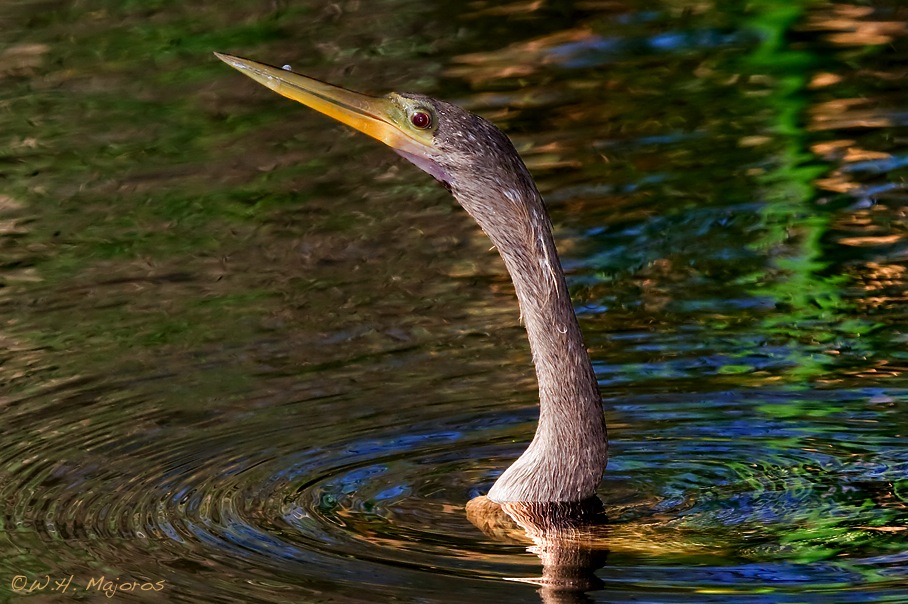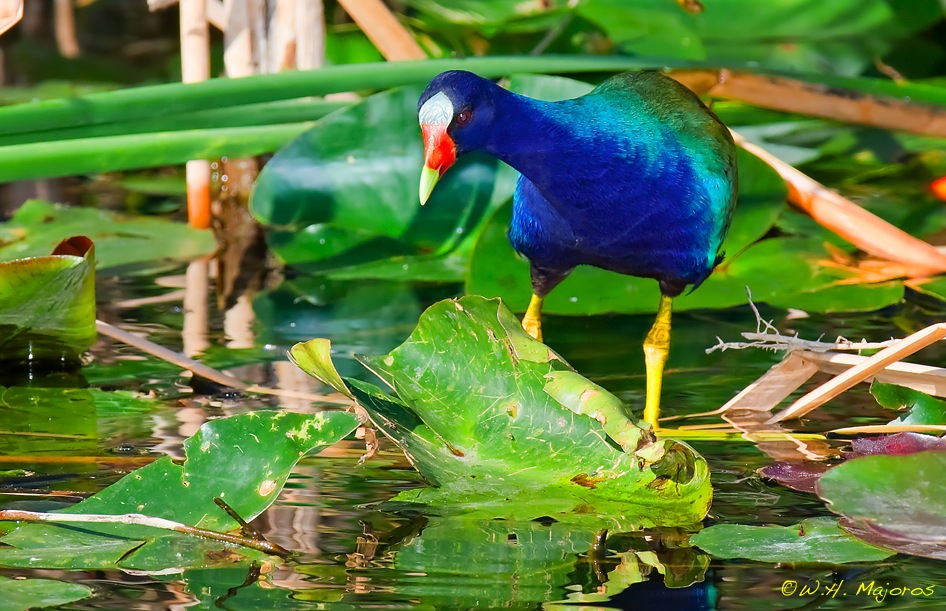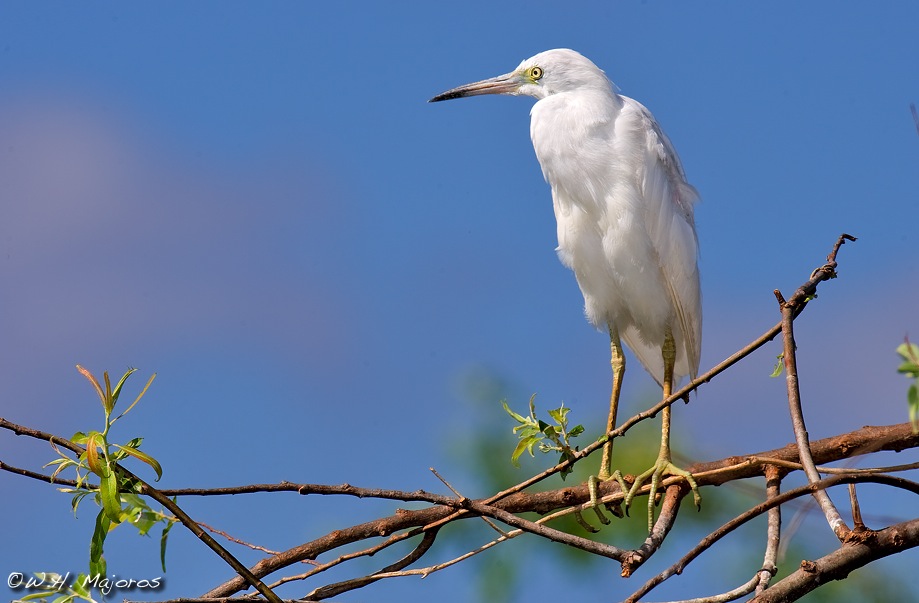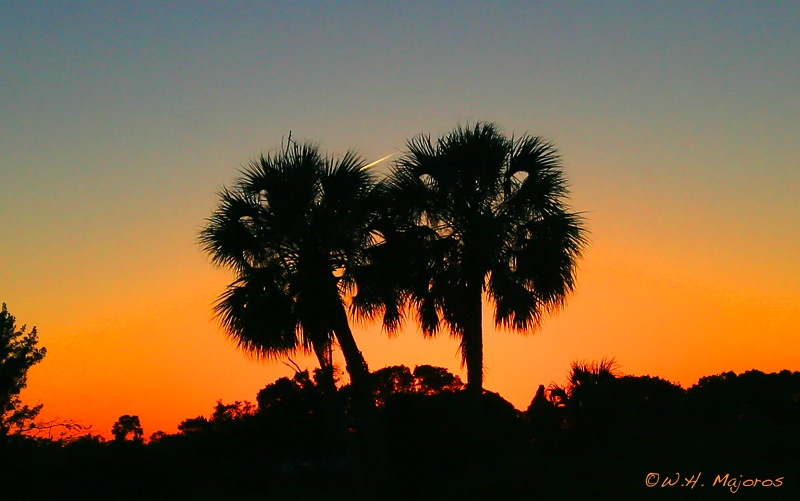Feb
28
Saturday
2837
photos
|
Today
I woke up much earlier (4am) than yesterday, since the drive from Miami
International Airport (where my dog-friendly hotel is located) to the
Everglades is a long one and I wanted to take advantage of the
early morning light. Noon lighting is typically not ideal for
bird photography, because it leaves the underside of the bird
unlit. Many bird photographers prefer early morning and late
afternoon, due to the angle of light from the sun, and also because of
the richer colors imparted as the sun’s rays pass through a larger
quantity of
atmosphere. Unfortunately, I found that a computer glich had
prevented my files from the previous day from being copied over to my
second
backup drive, so I had to spend several hours stuck in my hotel room
waiting for the backup to complete. I always upload my images
every night to two external drives, which are mirrors of each
other. One drive I leave in my hotel room and the other I take
with me and leave locked up in the trunk. That way, if either my
car or my hotel room is burglarized when I’m out in the field, I’ll
still have a copy of all my images. Cameras and lenses can be
replaced (especially if they’re insured), but images are unique.
My destination this morning was Shark
Valley, a site within Everglades
National Park (off of route 41). As it turns out, this site
doesn’t open till 8:30am, so my computer problems hadn’t cost me any
actual shooting time. There were quite a number of photographers
there, but only one or two really serious shooters with big lenses; the
rest were mostly tourists with sub-300mm lenses. The site is
actually quite small, at least the part that’s reputed to be any good
for bird photography. There’s a channel of water much like a
canal that extends from the parking lot beside a wide trail. The
serious bird photographers informed me that it’s pretty futile to go
much further than about 100 yards down this trail.
The nice thing about Shark Valley is that if you can see the bird at
all, then it’s typically very close. I had been wanting a shot of
an
Anhinga sticking just its neck and head out of the water like a snake,
and I was finally able to get one here:

Anhinga at Shark
Valley, in the Everglades.
Canon EOS 1D Mark III camera with Canon 400mm f/4 DO lens.
1/500 sec at ISO 640, f/9. Fill flash on high-speed sync at full
power (+3).
The bad thing about Shark Valley is that the backgrounds are, for the
most part, very "busy" and distracting, just as along the Anhinga
Trail. The Green-backed Heron image below illustrates this somewhat,
though this was one of the least "busy" of the photos I took at Shark
Valley:
Green-backed
Heron at Shark Valley, in the Everglades.
Canon 600mm f/4 lens, stopped down to f/11.
1/320 sec at ISO 400. Flash at +3 on high-speed sync.
Despite the sub-optimal backgrounds, I was glad for the opportunity to
shoot
Green-backed Herons, since I rarely get close enough to them in North
Carolina. As a bonus, I even got to shoot some Green-backed Heron
chicks. These two fellows (below) were across the narrow channel
from
where I was standing with the big 600mm lens:
Green Heron
Chicks
at Shark Valley.
Canon 600mm f/4
lens, stopped down to f/11.
1/400 sec at ISO 400. Flash at +3 on high-speed sync.
You can see from the downy feathers on their heads
that they’re chicks,
though they’ve obviously left the nest and are approaching the size of
an adult. These were the first Green-backed Heron chicks I’d ever
seen, so I was happy just to have found them.
By far, the most exciting find for me that morning was the Purple
Gallinule pictured below. I had never seen one before, and
wasn’t
even aware that they occurred in the Everglades. The bird is
fairly small, probably smaller than a chicken, but with enormous feet
(not shown) that it can use to walk on lily pads with ease. The
bird’s
plumage is iridescent, with
many subtle colors that can only be seen well in bright sunlight (or
with flash).
The bird pictured below came out and foraged on the water near the far
shore of the channel for only a few minutes before disappearing again
in
the marshy woods on the far side. (Later on this trip I’ll see
some Common Gallinules, which
have a similar, colorful beak, but with a
mostly black body).

Purple Gallinule
at Shark Valley.
Canon 600mm f/4
lens, stopped down to f/11.
1/250 sec at ISO 400. Flash at +3 on high-speed sync.
For the more serious photographers assembled at Shark Valley that day,
the main attraction was a particularly active Tri-colored Heron (see
below) that was foraging in the channel. The bird would perch on
a
log and intently watch the water’s surface till suddenly
it made a rapid foray out over the water in hopes of procuring a fish:
A Very Active
Tri-colored Heron at Shark Valley.
Canon 70-200mm f/2.8 lens at 200mm, f/9.
1/1600 sec at ISO 640.
The bird gave us quite a workout. Just when all the photographers
had settled into a ready position to shoot the bird on its next foray,
the bird would move to another location a bit upstream or downstream,
forcing us all to hustle to new positions in preparation for the bird’s
next move. In the end, I didn’t really get any useful shots of
the bird’s hunting attempts; the problem was the light:
though I was able to get shots of the bird poking its head into the
water to catch a fish, the sunlight never illuminated enough of the
bird to make for a pleasing image. The use of flash didn’t help
either, since I had to use a relatively fast shutter speed to freeze
the quick motions of the bird. Probably the worst problem I had
with this bird was due to the sunlight hitting the white underside of
the bird. That bright sunlight reflecting off of white feathers
set an upper limit on my exposure values, since I had to ensure that I
didn’t blow the highlights in the white regions of the bird’s
plumage. At the same time, the undersides of the wings were
typically in shadow and ended up being highly underexposed. A
friendly photographer of German or Austrian origin agreed that properly
exposing this bird was very difficult, and would only be rendered
manageable by cloud cover. I was able to produce the above image
only by using flash at close range and then turning up the "fill light"
slider in Adobe Camera Raw.
Another first for me was the white-phase Little Blue Heron that you can
see pictured below :

Little Blue Heron
(White Phase) at Shark Valley.
Canon 600mm f/4
lens, stopped down to f/11.
1/250 sec at ISO 100. Flash at +3 on high-speed sync.
The Little Blue Heron goes through a white phase before
obtaining the blue-red colors of the adult. Most of the other
North American herons don’t go through such a white phase. Once
again, I found that photographing a bird with a white ventral side in
bright sunlight resulted in underexposed shadow areas. Because
the bird was perched across the canal and high up on a tree bough,
normal fill flash probably wouldn’t have helped tremendously.
Fortunately, my homemade, 14-inch flash extender ("beamer"), coupled
with the fact that I could use slow shutter speeds (since the bird was
stationary) allowed me to light up the shadows on this bird quite well,
as you can see in the image above.
Although I didn’t see any sharks at Shark Valley, I did see plenty of
gators. Pictured below is one individual who sneaked up on me
while I was searching for a submerged anhinga:
Gator at Shark
Valley.
Canon 70-200 lens at 200mm, f/8.
f/800 sec at ISO 500. Fill flash at full power.
I should note that Shark Valley really
doesn’t
require huge focal lengths, in general. Of the serious
photographers I met there that day, few had anything larger than
400mm. Because the waterway paralleling the trail is only about
20 feet wide,
the birds tend to be very close, so 400mm or even 300mm lenses can be
quite useful, and for the large, active birds like the Tri-colored
Heron mentioned earlier, a 200mm zoom can be very useful as well.
Around noon I left Shark Valley and headed back toward the east
entrance to Everglades National Park, with Eco Pond being my intended
destination. Unfortunately, due to some misleading signs along
the way, I ended up on a dead-end dirt road in the middle of nowhere
and had to back-track to
the nearest highway, wasting a half hour of travel time. Around
2-ish I finally arrived at the campgrounds near Flamingo, where my dog
could cool off in the water while I looked for dolphins. I did
eventually see one, way off in the distance:

Dolphin near
Flamingo in Everglades National Park
Canon 600mm f/4 lens stopped to f/8. 1/500 sec at ISO 250.
Around 3-ish I headed to nearby Eco Pond. Inspection of the
Black-necked Stilt images from last night showed that I hadn’t been
using fast-enough shutter speeds to freeze the foraging movements of
the
birds, so I hoped to get some sharper images by using higher shutter
speeds at higher ISO settings. Below are just a few of the
thousands of images I took at Eco Pond that afternoon:
Black-necked
Stilt at Eco Pond.
Canon 600mm f/4 lens plus 1.4x teleconverter.
840mm at f/8. 1/1250 at ISO 400. No flash.
When taking so many photos of the same species of bird at the same
location, it’s nice if you can somehow vary the angle of the shots from
time to time, in order to vary the color or brightness of the
backgrounds. The image above was taken from the area directly in
front of my position, which has a brown foreground and a whitish
background. The image below was shot off to my right, where there
is more green foliage to reflect off the water:
Black-necked
Stilt at Eco Pond.
Canon 600mm f/4
lens plus 1.4x teleconverter.
840mm at f/8. 1/1600 at ISO 400. No flash.
Until the sun had fallen lower toward the horizon, many of the
backgrounds would be largely devoid of color if there was no greenery
to reflect off the water. In the case of the image below, the
white sand of the foreground together with the blurred and colorless
background ended up almost producing the illusion that I was shooting a
misty morning scene:
Black-necked
Stilt at Eco Pond.
Canon 600mm f/4
lens plus 1.4x teleconverter.
840mm at f/8. 1/1600 at ISO 400. No flash.
As sunset approached, the colors once again came out, just like last
night (which a bit of saturation in Photoshop helped to bring out —
being careful not to bring out too much yellow in the bird’s underside,
nor too much red in its legs):
Black-necked
Stilt at Eco Pond.
840mm at f/7.1. 1/1000 at ISO 250.
Fill flash on high-speed sync at full power (+3).
My two afternoons at Eco Pond in the Everglades were extremely
enjoyable, mostly because I was shooting one of my favorite birds —
the Black-necked Stilt. This was to be my last day at Eco,
though, since I was becoming more and more impatient to get to some of
the sites further north. In contrast to my plan of visiting sites
in south-to-north order (to coincide with the progression of arrival of
spring), most of the other photographers and birders I’ve been meeting
have been working their way south, and they’ve mostly reported that
sites further north such as the Venice Rookery and Fort DeSoto Park
have been excellent in the past week or two. One exception is
Ding Darling NWR on Sanibel Island, which everyone I’ve met has found
to be terrible for bird photography, despite its venerable
reputation. I was told not to waste my time driving to Sanibel at
all.
Strangely, I didn’t
encounter many other photographers at Eco Pond, and of those that I did
see there, none of the others were using the approach-low and
shoot-at-eye-level technique, which I am finding produces the most
satisfying
images. I’m now rarely satisfied to shoot high from a tripod, at
least for ground-foraging and water-based birds. The birds at Eco
Pond showed almost no concern about my close proximity, even when I
stood up to gather my things and leave.

Sunset at Eco
Pond.
Tamron 12-24mm lens at 24mm, f/9.
1/500 sec at ISO 400.
|